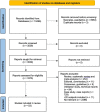The rate and assessment of muscle wasting during critical illness: a systematic review and meta-analysis
- PMID: 36597123
- PMCID: PMC9808763
- DOI: 10.1186/s13054-022-04253-0
The rate and assessment of muscle wasting during critical illness: a systematic review and meta-analysis
Abstract
Background: Patients with critical illness can lose more than 15% of muscle mass in one week, and this can have long-term detrimental effects. However, there is currently no synthesis of the data of intensive care unit (ICU) muscle wasting studies, so the true mean rate of muscle loss across all studies is unknown. The aim of this project was therefore to systematically synthetise data on the rate of muscle loss and to identify the methods used to measure muscle size and to synthetise data on the prevalence of ICU-acquired weakness in critically ill patients.
Methods: We conducted a systematic literature search of MEDLINE, PubMed, AMED, BNI, CINAHL, and EMCARE until January 2022 (International Prospective Register of Systematic Reviews [PROSPERO] registration: CRD420222989540. We included studies with at least 20 adult critically ill patients where the investigators measured a muscle mass-related variable at two time points during the ICU stay. We followed Preferred Reporting Items for Systematic Reviews and Meta-Analyses (PRISMA) guidelines and assessed the study quality using the Newcastle-Ottawa Scale.
Results: Fifty-two studies that included 3251 patients fulfilled the selection criteria. These studies investigated the rate of muscle wasting in 1773 (55%) patients and assessed ICU-acquired muscle weakness in 1478 (45%) patients. The methods used to assess muscle mass were ultrasound in 85% (n = 28/33) of the studies and computed tomography in the rest 15% (n = 5/33). During the first week of critical illness, patients lost every day -1.75% (95% CI -2.05, -1.45) of their rectus femoris thickness or -2.10% (95% CI -3.17, -1.02) of rectus femoris cross-sectional area. The overall prevalence of ICU-acquired weakness was 48% (95% CI 39%, 56%).
Conclusion: On average, critically ill patients lose nearly 2% of skeletal muscle per day during the first week of ICU admission.
Keywords: Critical illness; ICU-AW; ICU-acquired weakness; Intensive care unit; Muscle atrophy; Muscle wasting.
© 2023. The Author(s).
Conflict of interest statement
SJS received grants and non-financial support from Reactive Robotics GmbH (Munich, Germany), ASP GmbH (Attendorn, Germany), STIMIT AG (Biel, Switzerland), ESICM (Geneva, Switzerland), grants, personal fees and non-financial support from Fresenius Kabi Deutschland GmbH (Bad Homburg, Germany), personal fees from Springer Verlag GmbH (Vienna, Austria) for educational purposes and Advanz Pharma GmbH (Bielefeld, Germany), non-financial support from national and international societies (and their congress organizers) in the field of anesthesiology and intensive care medicine, outside the submitted work. Dr. Schaller holds stocks in small amounts from Alphabeth Inc., Bayer AG and Siemens AG; these holdings have not affected any decisions regarding his research or this study. All other authors have no conflict of interest to declare.
Figures
References
-
- Fan E, Cheek F, Chlan L, Gosselink R, Hart N, Herridge MS, Hopkins RO, Hough CL, Kress JP, Latronico N, Moss M, Needham DM, Rich MM, Stevens RD, Wilson KC, Winkelman C, Zochodne DW, Ali NA; ATS Committee on ICU-acquired Weakness in Adults; American Thoracic Society. An official American Thoracic Society Clinical Practice guideline: the diagnosis of intensive care unit-acquired weakness in adults. Am J Respir Crit Care Med. 2014;190(12):1437–46. doi:10.1164/rccm.201411-2011ST. - PubMed
-
- de Letter MA, Schmitz PI, Visser LH, Verheul FA, Schellens RL, Op de Coul DA, et al. Risk factors for the development of polyneuropathy and myopathy in critically ill patients. Crit Care Med. 2001;29(12):2281–6. - PubMed
Publication types
MeSH terms
LinkOut - more resources
Full Text Sources
Medical



